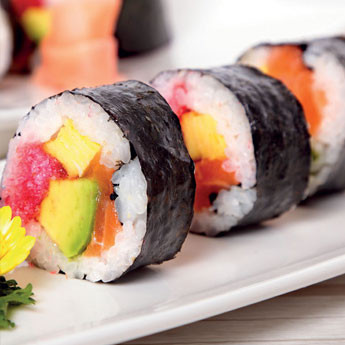Nori Seaweed (Porphyra SP.) is the kelp that is eaten in “sheets" and is certainly the most “enjoyed” in the world (Japan on its own produces about 11 billion pieces per year). It is produced by grinding and reducing red Nori seaweed to a pulp. The pulp is then poured, in small amounts, into boxes placed on bamboo mats, where the extra pulp gets drained off. The seaweed covered mats are then left to dry in the sun, or put in special ovens. This process gives the seaweed its recognizable form, a black-purple sheet.
The genus Porphyra alga that is used in the preparation of Nori seaweed provides a balanced supply of vitamins, minerals, Omega-3, as well as a high protein content.
It is assumed that the eating of Porphyra began in China and dates back to 533-544 A.D. Nori seaweed is dried and is sold in little square sheets. A good-quality Nori is glossy, has some green highlights, and a uniform grain.
It should be stored in a closed container to preserve its fragrance.
Perchè mangiarlo
Nori seaweed is rich in fiber and in minerals.
It has a high iron content, essential for the maintenance of the normal function of the immune system, and contains potassium, a precious ally for blood pressure.
It supplies a good amount of vitamins, in particular, vitamins C and A.
Nori seaweed also contains a great quantity of essential trace elements, such as zinc, manganese, copper, and selenium, which are essential for the body's metabolic processes.
Finally, Nori seaweed is an important source of iodine, something which it has in great quantities.

Nori Seaweed is famous for its use in Sushi Maki, but there are a thousand delicious snacks that you can create with this delicacy: with olives, artichokes, mushrooms, tuna, eggs, and fish eggs, etc. It can also be cut into 3/4 cm [1-1/3 in.] pieces and added at the end of the cooking time in light soups, creams, and hearty soups.
Very delicate in flavor, Nori is also pleasing to those palates that are less accustomed to the taste of seaweed.









 Indietro
Indietro











